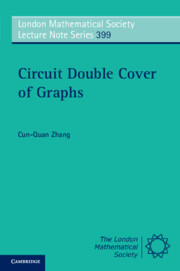Book contents
- Frontmatter
- Contents
- Foreword
- Foreword
- Preface
- 1 Circuit double cover
- 2 Faithful circuit cover
- 3 Circuit chain and Petersen minor
- 4 Small oddness
- 5 Spanning minor, Kotzig frames
- 6 Strong circuit double cover
- 7 Spanning trees, supereulerian graphs
- 8 Flows and circuit covers
- 9 Girth, embedding, small cover
- 10 Compatible circuit decompositions
- 11 Other circuit decompositions
- 12 Reductions of weights, coverages
- 13 Orientable cover
- 14 Shortest cycle covers
- 15 Beyond integer (1, 2)-weight
- 16 Petersen chain and Hamilton weights
- Appendix A Preliminary
- Appendix B Snarks, Petersen graph
- Appendix C Integer flow theory
- Appendix D Hints for exercises
- Glossary of terms and symbols
- References
- Author index
- Subject index
9 - Girth, embedding, small cover
Published online by Cambridge University Press: 05 May 2012
- Frontmatter
- Contents
- Foreword
- Foreword
- Preface
- 1 Circuit double cover
- 2 Faithful circuit cover
- 3 Circuit chain and Petersen minor
- 4 Small oddness
- 5 Spanning minor, Kotzig frames
- 6 Strong circuit double cover
- 7 Spanning trees, supereulerian graphs
- 8 Flows and circuit covers
- 9 Girth, embedding, small cover
- 10 Compatible circuit decompositions
- 11 Other circuit decompositions
- 12 Reductions of weights, coverages
- 13 Orientable cover
- 14 Shortest cycle covers
- 15 Beyond integer (1, 2)-weight
- 16 Petersen chain and Hamilton weights
- Appendix A Preliminary
- Appendix B Snarks, Petersen graph
- Appendix C Integer flow theory
- Appendix D Hints for exercises
- Glossary of terms and symbols
- References
- Author index
- Subject index
Summary
Girth
The girth of a smallest counterexample to the circuit double cover was first studied by Goddyn [82], in which, a lower bound 7 of girth was found. Later, this bound was improved as follows: at least 8 by McGuinness [179], and at least 9 by Goddyn [83] (a girth bound of 10 was also announced in [83]). The following theorem, proved with a computer aided search, remains the best bound up to today.
Theorem 9.1.1 (Huck [115]) The girth of a smallest counterexample to the circuit double cover conjecture is at least 12.
It was conjectured in [132] that cyclically 4-edge-connected snarks may have bounded girths. If this conjecture were true, then the circuit double cover conjecture would be followed immediately by Theorem 9.1.1 (or an earlier result in [82] for girth 7). But this is not the case: in [146], Kochol gave a construction of cyclically 5-edge-connected snarks of arbitrarily large girths.
However, Theorem 9.1.1 (or its earlier results) remains useful in the studies of some families of embedded graphs with small genus since the girth of such graphs is bounded (see Section 9.2).
Small genus embedding
The circuit double cover conjecture is trivial if a bridgeless graph is planar: the collection of face boundaries is a double cover. How about graphs embeddable on surfaces other than a sphere? Although it is known that every bridgeless graph has a 2-cell embedding on some surface, it is not guaranteed that face boundaries are circuits (see Section 1.4).
- Type
- Chapter
- Information
- Circuit Double Cover of Graphs , pp. 112 - 116Publisher: Cambridge University PressPrint publication year: 2012



